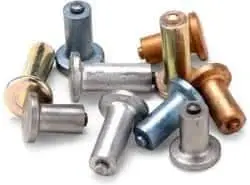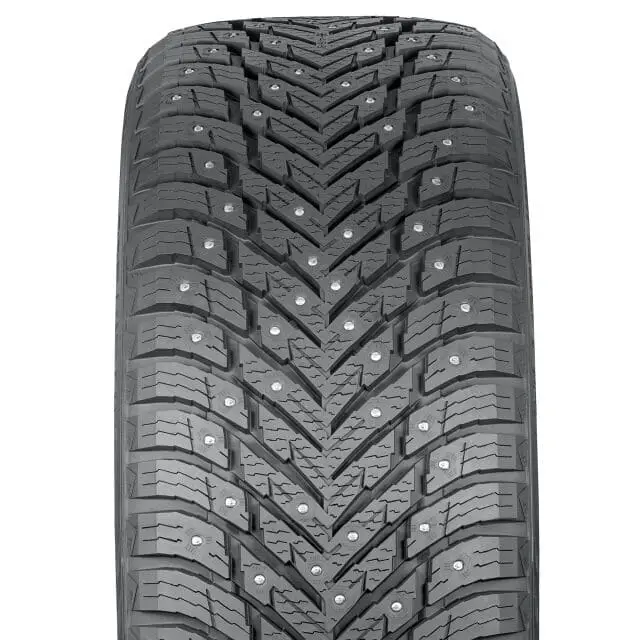You might have observed that when there is snow or water on the road, the tires skid or slip over the road. Around the 1960s, researchers in the US introduced studded tires to cope with this problem. They were meant to improve traction and control in slippery and snowy conditions.
But one might ask that what are these studded tires, when do we need them? And most importantly, how long do these tires last? Let’s explore all these things in this article.
What are Studded Tires?
Generally, a stud is a large-headed piece of metal that pierces and projects out from a surface. In the same way, studded tires are those tires that have some tiny sharp knife-edge metal studs inserted into their treads.

A tire stud comprises of two parts, a tungsten carbide pin, and a cylindrical metal jacket. The tungsten carbide pin is the part of the tires that extends beyond the tread and makes contact with the ground. A cylindrical metal jacket is placed on the outside of the stud in the tire tread rubber. It is supported by a flange at the base.
When do we need Studded Tires?

During winter, in regions with huge snow-fallings, the roads are covered with snow. The snow lessens the friction between the tire and the road. This causes skidding of the car. In order to get rid of this danger, studs are added over the tire treads. These studs dig into the ice or thick snow and provide better traction. The chance of skidding is reduced greatly due to the addition of these studs.
Mostly, these studded tires are needed in winter, in mountainous areas where snow often covers the roads. Studded tires are also referred to as winter tires. Non-studded tires do not provide enough grip on snowy roads. It is very dangerous to drive on a snow-covered road without studded tires. So, it is advised to use studded tires during the winter season as they provide stability during acceleration and shorter stopping distance.
How long do Studded Tires last?
Whenever you buy anything, first, you try to search out the life span of that product. So, you might think the same for studded tires, how long do they last?
We cannot precisely say, how long these tires will last because this thing depends upon multiple factors. Studded tires wear out rapidly if you drive more miles a day on the thick snowy road. In addition, this also depends upon the initial condition and quality of a tire. The material of the stud is also a main factor that affects the life of studded tires.
Some manufacturers offer the life of studded tires in terms of the distance that tire covers in miles or kilometers. The average life of a studded tire is 40,000 miles. However, some manufacturers claim that you can get four seasons of winter from the same studded tires.
According to the US Department of Transportation Federal Highway Administration, the distance, a normal studded tire can cover is 13,500 miles per year. So, if a person drives 2500 miles per month and we consider 4 months of winter in one year then still the tire will last about 4 seasons.
So, the claim of these manufacturers is valid. 2500 miles per month is more than the average distance a person travels. The tire may last up to 6 seasons also if your monthly traveling distance is less than that. It is also possible that because of good driving skills and less traveling on the thickened snowy road, the tire lasts more.
When do we need to replace studded tires?
Winter tires are meant for traction, not longevity. They will wear out surely, but do you know when do we need to replace them?
The studs are the main components that wear out first. So, the main indicator of wear is stud here. If studs lose their grip and wear out up to 2 mm, then you need to change your studs. Some manufacturers recommend replacing the tires when the tread depth becomes lower than 5/32”.
What are the advantages of using studded tires?
Studded Tires offer a range of benefits over non-studded tires. They provide a stable driving experience, cause no damage to vehicle parts, and provide better traction.
High strength: The studs are made up of tungsten carbide, whose strength is comparable to that of titanium.
- longer_content -->No need for Chains: LocalPeople normally use chains during winter. The chains are wound around the tire. But there’s a risk that they may break anytime. With the use of studded tires, you don’t need chains.
Stable Driving Experience: Driving on snowy roads with or without chains can cause vibrations. But with studded tires, you can get a stable and comfortable driving experience.
No damage to Vehicle: If in snowy conditions, you choose chains. Then, they can damage the exterior and other components of tires. But the studded tires do no harm to the vehicle.
Better Traction in Descending Slopes: Studded tires are best when you are descending down a slope, they provide better grip and traction.
What are some drawbacks of using studded tires?
Though studded tires provide a range of benefits, still they are noisy, wear down roads, are not legal in some states, and have a high cost.
Noise: Sincethe studded tires consist of a carbide pin, they are quite noisier when you drive them on the roads without snow.
Road Wear: Studded tires are also responsible for the wear of roads. Every year, it is estimated that the use of studded tires costs taxpayers millions of dollars in road wear. Furthermore, as studded tires wear down the concrete, they produce ruts in the road that fill with water and cause hydroplaning when it rains.
Not legal Everywhere: As mentioned earlier, studded tires have the ability to wear down roads. So, some states have outright banned studded winter tires or limited their use to the winter season. They are not legally permitted to use, everywhere.
High Cost: Thestudded tires cost more than normal tires. Their cost is about twice the normal tires. The average cost of a studded tire is around $500.
I hope by now, you might have got an idea of what studded tires are, and how long do they last. So, before buying these tires, keep in mind their pros and cons.

